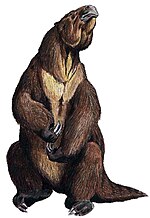Tinguiririca fauna
The Tinguiririca fauna comprises a group of mammals that lived in Patagonia 33 million to 31.5 million years ago . Before the discovery of numerous fossils in the Andean regions , the evolution of the mammals of South America during this time was unknown until a group of paleontologists in 1988 in the area of the Río Tinguiririca , a 65 km long river in the Chilean Región del Libertador General Bernardo O'Higgins , on fossil mammal bones came across.
background
30 million years ago, South America was a huge island that split off from the great continent Gondwana about 80 million years ago . During this time, the mammals of this continent developed into a unique fauna that did not arise on any other continent. It was not until 3.5 million years ago that North and South America combined to form a continent.
The first major mammalian evolution of South America took place forty million years ago when anteaters , some marsupials, and sloth precursors emerged. A second further development followed thirty million years ago. During the second evolutionary phase, monkeys and rodents appeared for the first time in South America, which had not evolved on the continent, but immigrated. Some species of guinea pig relatives such as chinchillas reached South America 50 million to 30 million years ago, i.e. millions of years before the continent was united with North America. Scientific investigations into the shape of the teeth revealed that the immigrated animals came from Africa and not via a chain of islands from North to South America. How they crossed the Atlantic is still unclear. Since this was not even 1,500 km wide at that time, paleontologists suspect that the immigration took place via flotsam with the help of strong east-west currents. Such a trip would have taken about two weeks. In order to survive during the 14-day journey, the animals possibly put themselves into an apathetic state during which their metabolic function was reduced.
Although no plants from the period 33 to 31 million years ago have appeared, it is believed that the mammals living at the time were fed by plants. Fossils from earlier times that were found in the Tierra del Fuego region confirm this thesis. In these fossils, the incisors were wide, the canines reduced or even absent - the characteristics of a herbivore. Many of the mammalian fossils from the area of the Río Tinguiririca have strongly raised tooth crowns, which protects against wear on the teeth. The teeth of recent groups of animals such as horses and deer are also built this way; Since these find their food in grasslands, it was probably the same with the animals of the Tinguiririca fauna. In those days this area was probably like the African savannah . Grasslands only emerged on other continents about 18 million years ago. This is probably not only due to climate change, but also to the movement of the plates, which caused the Andes to come into being and which continues to do so today. The mountain formation created valleys in which the prehistoric mammals settled. Surrounded by the mountains, there was little rainfall in these basins. Since this condition was unfavorable for the rainforests, grasses developed there that could cope better with the changed living conditions.
The excavations
The first fossil, a fossilized bone, was discovered in 1988 in the valley of the Río Tinguiririca by a group of paleontologists who were actually looking for dinosaur bones . It is said that the footprint of a dinosaur was seen in the area of the Río Tinguiririca. Although these regions had hardly been investigated by paleontologists up to now, since according to the opinion of the time no living beings could be preserved in volcanic rock, the paleontologists hoped to come across dinosaur bones and possibly also mammalian fossils. The expedition examined the slopes on both sides of the river uncovered dinosaur tracks and only fossils of fish and ammonites . Some of the researchers eventually came across bones that appeared to belong to mammals about a thousand meters above the river. In January, a second seven-member expedition was dispatched to discover more fossils in the valley of the Río Tinguiririca. Since then, a group of researchers has set out in the area almost every year. When the road to the Río Tinguiririca was not passable during another expedition in 1994, the paleontologists explored the valleys accessible to them and also found fossils there.
Eventually over 1500 mammalian fossils were uncovered, including still unknown mammal species, such as the oldest rodent in South America and four other species, Archaeotypotherium tinguiriricaense , Santiagorothia chilensis , the ancient hyrax and Eomorphippus , which belong to the order of the Notoungulata , i.e. to the South American ungulates , and as whose oldest representatives apply. Another find was a prehistoric species of marsupial Klahnia charrieri and the bones of a giant sloth . A skull of the unknown monkey species Chilcebus carrascoensis and a saber-toothed cat were also found.
The mammals of the Tinguiririca fauna are believed to have died out in a volcanic eruption, as evidenced by the volcanic rock under which they were buried. Over the millions of years, new volcanic eruptions in the Andes ensured that the fossils were buried deeper and deeper under solidified layers of lava that were 3 m high.
literature
- Wolfgang Schneider, Heinz Eikamp: Fossil mammalian teeth of the modern earth period (Cenozoic). From the Tertiary to the Pleistocene. (70 million years - 70,000 years ago) . NAOM, Obertshausen 2001, ISBN 3-9804820-8-1 , ( NAOM publication ).
- Spectrum of Science , September 2007 edition
